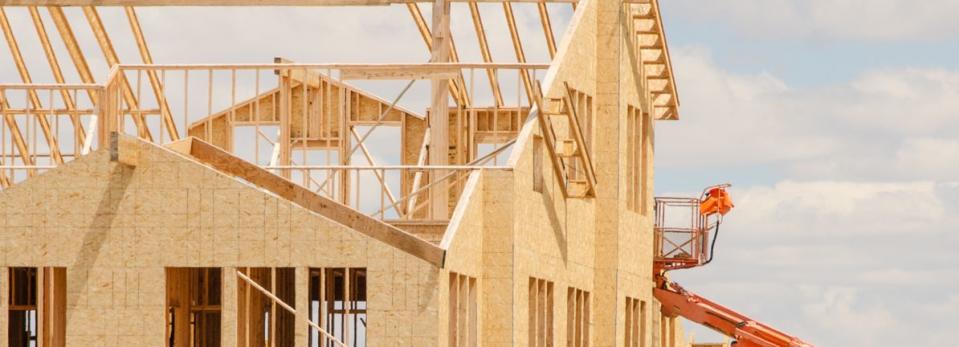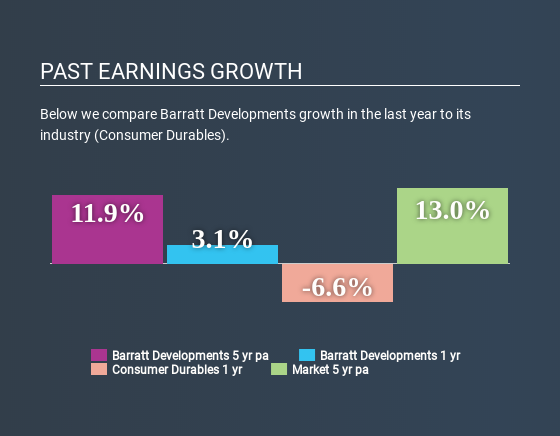Will Weakness in Barratt Developments PLC's (LON:BDEV) Stock Prove Temporary Given Strong Fundamentals?

It is hard to get excited after looking at Barratt Developments' (LON:BDEV) recent performance, when its stock has declined 43% over the past three months. However, a closer look at its sound financials might cause you to think again. Given that fundamentals usually drive long-term market outcomes, the company is worth looking at. Specifically, we decided to study Barratt Developments' ROE in this article.
Return on Equity or ROE is a test of how effectively a company is growing its value and managing investors’ money. Simply put, it is used to assess the profitability of a company in relation to its equity capital.
View our latest analysis for Barratt Developments
How Do You Calculate Return On Equity?
ROE can be calculated by using the formula:
Return on Equity = Net Profit (from continuing operations) ÷ Shareholders' Equity
So, based on the above formula, the ROE for Barratt Developments is:
16% = UK£753m ÷ UK£4.8b (Based on the trailing twelve months to December 2019).
The 'return' refers to a company's earnings over the last year. Another way to think of that is that for every £1 worth of equity, the company was able to earn £0.16 in profit.
What Is The Relationship Between ROE And Earnings Growth?
So far, we've learnt that ROE is a measure of a company's profitability. Based on how much of its profits the company chooses to reinvest or "retain", we are then able to evaluate a company's future ability to generate profits. Assuming all else is equal, companies that have both a higher return on equity and higher profit retention are usually the ones that have a higher growth rate when compared to companies that don't have the same features.
Barratt Developments' Earnings Growth And 16% ROE
To start with, Barratt Developments' ROE looks acceptable. Especially when compared to the industry average of 13% the company's ROE looks pretty impressive. Probably as a result of this, Barratt Developments was able to see a decent growth of 12% over the last five years.
As a next step, we compared Barratt Developments' net income growth with the industry and found that the company has a similar growth figure when compared with the industry average growth rate of 14% in the same period.
The basis for attaching value to a company is, to a great extent, tied to its earnings growth. It’s important for an investor to know whether the market has priced in the company's expected earnings growth (or decline). By doing so, they will have an idea if the stock is headed into clear blue waters or if swampy waters await. Has the market priced in the future outlook for BDEV? You can find out in our latest intrinsic value infographic research report.
Is Barratt Developments Using Its Retained Earnings Effectively?
Barratt Developments has a healthy combination of a moderate three-year median payout ratio of 34% (or a retention ratio of 66%) and a respectable amount of growth in earnings as we saw above, meaning that the company has been making efficient use of its profits.
Upon studying the latest analysts' consensus data, we found that the company's future payout ratio is expected to rise to 58% over the next three years. Therefore, the expected rise in the payout ratio explains why the company's ROE is expected to decline to 12% over the same period.
Summary
On the whole, we feel that Barratt Developments' performance has been quite good. In particular, it's great to see that the company is investing heavily into its business and along with a high rate of return, that has resulted in a sizeable growth in its earnings. Having said that, the company's earnings growth is expected to slow down, as forecasted in the current analyst estimates. To know more about the latest analysts predictions for the company, check out this visualization of analyst forecasts for the company.
Love or hate this article? Concerned about the content? Get in touch with us directly. Alternatively, email editorial-team@simplywallst.com.
This article by Simply Wall St is general in nature. It does not constitute a recommendation to buy or sell any stock, and does not take account of your objectives, or your financial situation. We aim to bring you long-term focused analysis driven by fundamental data. Note that our analysis may not factor in the latest price-sensitive company announcements or qualitative material. Simply Wall St has no position in any stocks mentioned. Thank you for reading.

 Yahoo Finance
Yahoo Finance 
